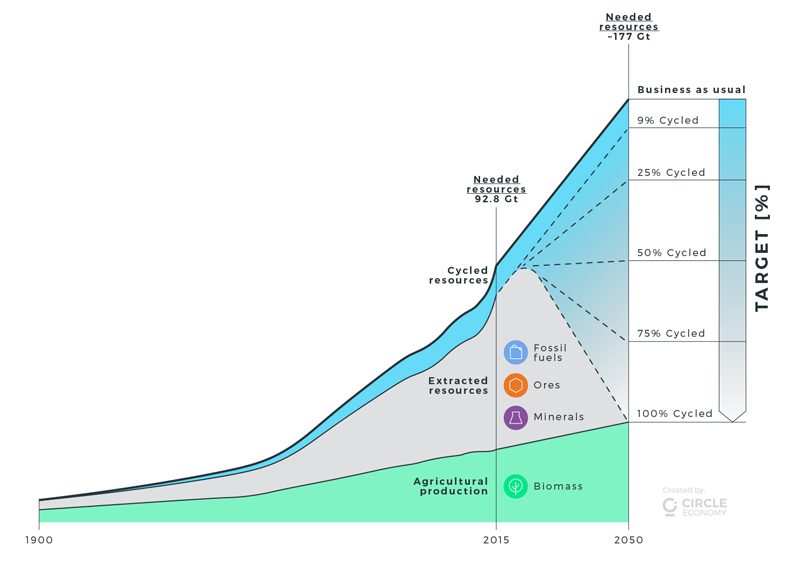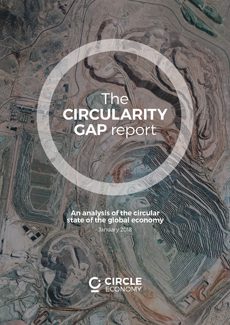
New Global Circularity Metric shows how much our current linear economy is failing people and the planet, say authors
With over 90% of the raw materials used globally not cycled back into the economy, our planet is left with a massive strain on its natural resources and climate that needs to be urgently relieved, according to a report launched by Circle Economy, a Netherlands-based social enterprise, at Davos on 23 January.
This alarming statistic is the main output of the first Circularity Gap Report, in which Circle Economy explores a metric for the circular state of the planet, which allows us to start measuring yearly progress to bridge the gap between what we use and what we cycle.
Launching the report at the World Business Council for Sustainable Development (WBCSD) CEO Breakfast, Circle Economy’s CEO and co-author Harald Friedl says:
“Being able to track and target performance via the Global Circularity Metric will help us engage in uniform goal-setting and guide future action in the most impactful way.”
The report presents a detailed metabolism visual showing how main resource groups satisfy key societal needs, such as housing, mobility and nutrition. It also presents the leaks in the system with an overview of what happens to resources after use in the economy.
Circle Economy has identified four steps to bridge the circularity gap through leadership and action.
1. Build a global coalition for action
2. Develop a global target and action agenda
3. Translate global targets to local action roadmaps
4. Improve our understanding of circular systems
Endorsed by leading representatives from governments, cities, think tanks and businesses (see below), the report highlights UN Environment statistics showing that a fully circular economy would both reduce global natural resource use by 28% and cut greenhouse gas emissions by 72% – thus significantly supporting the UN Sustainable Development Goals (SDGs) and the Paris Climate Agreement.

Mr Friedl adds:
“Today’s Take-Make-Waste economic model is not fit for purpose. Embedded in this tradition of the linear economy lies a toxic cocktail of negative consequences, ranging from social inequality, to depletion of natural resources, environmental pollution and worsening of the risks and effects of climate change. We call upon businesses and governments to take leadership to develop an action agenda and contribute to the global targets set in the SDGs and the Paris Agreement.”
Dr. Marc de Wit, Circle Economy’s Director of Strategic Alliances and lead author of The Circularity Gap Report, says:
“The real value of a global circularity metric, lies in being able to track changes over time and measure progress, put main trends into context, engage in uniform goal-setting and guide future action in the most impactful way. In order to understand how to move to a circular state globally we need to understand what is not circular about our economy today.”
Closing the circularity gap will reduce income inequality and improve access to basic needs and opportunities. In other words, pursuit of the circular economy is a way to create an economy that works for everybody. The circular economy is a positive, dynamic and interconnected solutions-based framework: it builds on key human qualities, such as creativity, collaboration and entrepreneurship; and is a roadmap towards achieving the SDGs and a powerful tool in the fight against human-made climate change”

A number of political and sustainability leaders endorsed the report, whose comments are included below.
Peter Bakker, President and CEO at WBCSD
“Moving towards the circular economy will be critical for addressing climate change and resource overuse. This report is a promising step forward in understanding our global progress on this front. Business will be essential in building momentum as we work to decouple economic growth from resource use. WBCSD’s circular economy program – Factor10 – brings global companies together to speed up the transition and deliver circular solutions, faster.”
Frans Van Houten, CEO at Royal Philips and co-chair at the Platform for Accelerating the Circular Economy:
“The traditional ‘take-make-dispose’ economic model endangers the achievement of the globally agreed Sustainable Development Goals. SDG Goal 3 — ‘Healthy lives and well-being for all at all ages’ – is at the core of the Philips mission and relies on ‘Sustainable consumption and production patterns’ (SDG12) to be achieved. I therefore welcome this first step towards a global circularity metric. This will allow us to better measure the material flows of the global economy and provide insights about key levers for moving to a circular economy.”
Kate Raworth, Senior Visiting Research Associate at Oxford University’s Environmental Change Institute and Senior Associate at the Cambridge Institute for Sustainability Leadership:
“The twentieth century was ruled by the metric of money, which demanded endless growth. This century calls for new metrics – natural and social – that enable humanity to thrive within the means of the planet. This fascinating report presents just the kind of powerful numbers needed to start making that new economy real.”
Jyrki Katainen, European Commission Vice-President for Jobs, Growth, Investment and Competitiveness:
“This report gives a very concrete and tangible analysis and way forward for the circular economy and is a good contribution, supporting the efforts of many policymakers. The European Commission is very dedicated towards the achievement of the SDGs and is committed to transforming the European economy towards a more sustainable, low carbon, resource efficient future. We are convinced that we can only achieve this together through a broad collaboration of all stakeholders – across national borders – to make our systems fit for the challenges of today. This report illustrates how much more effort is still needed.”
Mark Watts, Executive Director, C40 Cities Climate Leadership Group:
“The Circularity Gap Report marks an important step in rethinking traditional linear resource management in order to transition to innovative models of continual reuse. The report underlines the key role for cities in this transition, supporting C40 research that improved waste and materials management is a vital area of intervention for mayors and an urgent priority for preventing the worst effects of climate action.”
On the circular economy:
Achim Steiner, Administrator United Nations Development Program (UNDP)
“Only 14% of all plastic packaging is recycled and vast quantities escape into the environment, resulting in a loss of USD 80 to 120 billion per year, and the possibility of more plastic than fish (by weight) in the ocean by 2050. We have an opportunity with the circular economy to rethink how we use resources like plastic and become a more responsible custodian of the planet. By using resources more efficiently and creating policies and economic infrastructure that encourage recycling and reuse, we can advance both Agenda 2030 and the Paris Agreement.”






